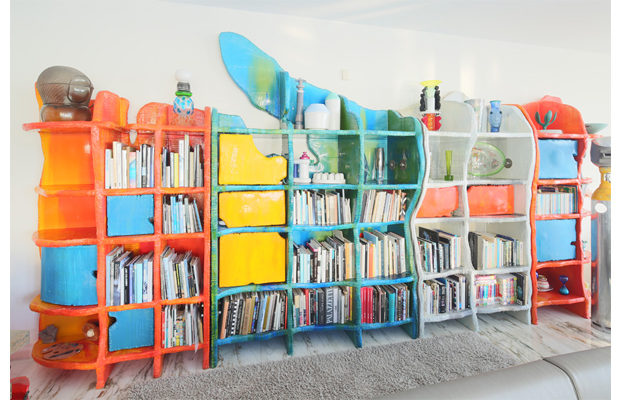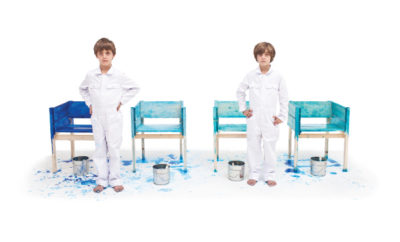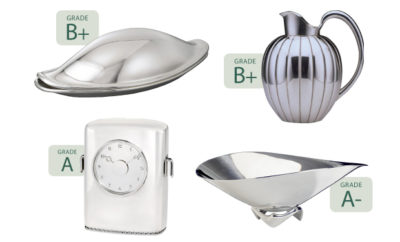
Design
Not a Still Life

Gaetano Pesce’s Miami Sound bookcase, 1995–1996, in our home. The drawing is one of several that Pesce supplied during the design process. Photos by Robin Hill.
Gaetano Pesce is an architect, industrial designer, artist, painter, and philosopher, and he has been my dear friend for more than twenty years. In our long conversations and by studying his work, I have come to admire him for his endless curiosity and as someone who looks only forward, never back. He is always experimenting, never satisfied, always evolving, breaking every mold that has stood in his way for close to fifty years.

“Perfection” is not high in his vocabulary. Gaetano’s idea of beauty is that “mistakes instead of perfection is beautiful.” A spot-on example is the Miami Sound bookcase I commissioned from him in 1995. I had recently met Gaetano and called to see if it was possible for him to design a seventeen-foot-long bookcase for me. His response: “You can’t afford it.” This was even before I gave him my modest budget for the piece. He later called back and told me that he would consider my commission if I was willing to participate in an experiment with him. I had not known then that resin as he used it, one of his favorite materials, was a very expensive way to produce chairs, tables, bookcases, and other objects.
Gaetano proposed a cabinet with both shelves and doors. Trying to be more cost effective, he proposed to make a four-section skeleton of the piece in Styrofoam. Once the skeleton was complete, he would strengthen and finish the cabinet by pouring numerous layers of resin on each section, turning and flipping the skeleton between each new layer of plastic so that each section of the cabinet would be stronger. As each layer of plastic dried, droplets looking like stalactites attached to most of the surfaces.
After many months of experimenting, the cabinet was ready to be shipped to my home in early 1996. My excitement was intense; several of my friends came over and unpacked the four sections of Miami Sound and bolted them together for me. What an incredible commissioned piece by my favorite designer! My friends and family were in awe. However, after a few days, the cabinet started having a life of its own. Shelves and some of the doors started changing shape. Mostly the cabinet sections were “bowing out.” I waited some time to get the courage to call my hero and tell him his cabinet was falling apart.

We were ultimately so pleased with Miami Sound that we commissioned Pesce to create the Pictures in an Exhibition cabinet, 1996–1997. Perhaps to avoid another episode of the cabinet “coming alive,” Pesce agreed to use wood as the base, rather than Styrofoam.
Finally, I called and told him about the situation. Within milliseconds Gaetano responded, “the cabinet is alive and beautiful. I so wish I was there to see my work evolving.” I brought him back to earth and told him that I had commissioned a cabinet/bookcase and this “thing” had a life of its own. My wife wanted it out of the house! She sensed that dangerous gases must be forming from a reaction between the Styrofoam and the resin. And she was right. Gaetano came up with another brilliant idea, take out a drill and drill holes in the cabinet to release the gases that had formed. I responded, “Are you crazy telling me to drill ¼-inch holes into numerous shelves in a cabinet I have just commissioned from you?” “Al, you must,” he insisted. I agreed to experiment on one shelf, but only if he promised to send me an autographed patch to glue over the hole after I drilled it. He agreed and I drilled a hole in my new cabinet. Immediately, the gases escaped from the space between the Styrofoam and the resin. However, the shelf did not flatten back out. This pleased Gaetano: “Imperfection is beautiful, that is what I’m trying to express,” he told me. I fumed at his comment then. Now, almost twenty years later, I know that the reaction between the materials stopped within weeks of arrival, and that the Miami Sound cabinet is more beautiful today than the day it arrived. We were so pleased with it that we immediately commissioned another cabinet from Gaetano—Pictures in the Exhibition, also shown here.
Domitilla Dardi, co-curator of a Pesce retrospective at the Maxxi Museum in Rome in 2014, has perhaps summed up Gaetano best. “Pesce has always been a pioneer. Not only does he bring art and craftsmanship into industrial production, he also permeates all his work with a strong message of reflection. His objects aren’t merely functional, they provoke thinking, ideas, doubts and sometimes even uncertainties.” And sometimes a little gas.












